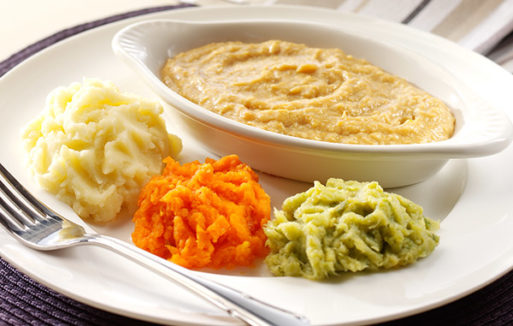
Credit: steinhardt.nyu.edu
Today, SevenPonds concludes our interview with speech-language pathologist Erin Embry. Erin holds a dual degree in both Communication Sciences and Disorders and Health Policy and Management. She is also Director of the Speech@NYU online MS program in Communicative Sciences and Disorders and the graduate student academic advisor. In her clinical work, Erin focuses on treating swallowing disorders. She recently contributed to a cookbook featuring recipes tailored to meet the needs of those who suffer from dysphagia.
Ellary: What is NYU Steindhardt’s Dysphagia Iron Chef Competition and how did the annual competition get started?
Erin Embry: The Dysphagia Iron Chef Competition is a challenge that is the culminating experience of one of the Speech@NYU courses, “Interdisciplinary Case-Based Management of Dysphagia.” Students from the varied disciplines of communicative sciences and disorders and nutrition and food studies are given a hypothetical patient profile. Once they have collaborated to analyze the needs of their patient (including their medical diagnosis, recommended diet, and cultural and psychosocial considerations), they develop recipes to meet their patients’ individual needs. Then, the different recipes are tested and ultimately judged. This year was the fifth annual Dysphagia Iron Chef Competition.
Ellary: Who judges the competition and how are the recipes evaluated?
Erin: This year, the judges consisted of an esteemed panel from NYU Steinhardt, Rusk Rehabilitation, and the food and nutrition communities. Two of our “celebrity judges” were Rocco DiSpirito and Michael Ferraro. They judged the recipes on creativity, taste, texture, nutrition and overall eating experience.
Ellary: You recently contributed to a cookbook called “Dining With Dysphagia.” How did this cookbook come together?
Erin: The “Dining with Dysphagia: A Cookbook” is a result of the Dysphagia Iron Chef Competition. Every year, we take the winning recipes from the competition and create an book full of delicious, easy recipes that are aimed at making eating an enjoyable experience for patients with all levels of swallowing difficulties. This particular recipe book outlines eight easy-to-follow and easy-to-swallow recipes that, quite frankly, anyone would enjoy. I’ve made a few of them myself! This cookbook is also meant to be the catalyst to starting a larger conversation around dysphagia.

A dysphagia diet doesn’t have to be boring
Credit: softerfoods.co.uk
Ellary: What do the recipes aim to achieve? What makes a recipe intended for someone with dysphagia different from recipes intended for someone who doesn’t have dysphagia?
Erin: Each year, the simple act of eating becomes a serious challenge for millions of people. As I mentioned, older adults are disproportionately affected, but dysphagia can become a challenge to just about anyone, including children and those with diseases such as Parkinson’s, head and neck cancers, acute neurological conditions, and many more. Caregivers, hospitals, and families caring for those with dysphagia might have to alter the textures of the foods and liquids in order to meet nutrition and medical needs.
Unfortunately, the affected people all too often find that the food is unappetizing and doesn’t take into account cultural food preferences. Likewise, a minimal focus is placed on aesthetics. These foods are often presented as “mushy.” To change this dynamic, the recipes in “Dining with Dysphagia: A Cookbook” take things up a notch, elevating pureed food to a higher standard. By focusing on all of the values foodies would appreciate – enhancing flavor, texture, aroma, and, of course, deliciousness – these recipes make the joy of eating available to everyone. Food should always nourish the body and soul. We should never assume that because a patient has swallowing problems that their food choices will be limited to pureed mush.
Ellary: The recipe contributions take into account the diversity of cultural backgrounds that dysphagia patients come from. How does accounting for this diversity affect ingredient choices?
Erin: While the recipes were evaluated for the overall joy of eating good food, the judges also took into consideration that dysphagia clients come from different cultural backgrounds. Diversity in ingredients and balanced tastes should be enjoyed by everyone – even those with chewing and swallowing difficulties.

Credit: dysphagiasupply.com
Ellary: Can you talk a little bit about dysphagia management beyond adjusting one’s diet? What are the other aspects of a typical treatment plan?
Erin: It’s incredibly important to consult with your doctor (or your loved one’s doctor) regarding dietary and medical requirements based on your specific dysphagia condition. A medical professional will be able to provide you with a comprehensive treatment plan, because everyone is different. This cookbook represents only suggestions to improve flavor and eating experience, not a medical opinion.
Ellary: Thank you, Erin, for sharing your expertise and speaking with SevenPonds!
Erin: You’re very welcome!
Did you miss part one of Erin’s interview? If so, feel free to catch up here.

 What is Dysphagia and How Can The Eating Experience Be Enhanced For Those Who Suffer?
What is Dysphagia and How Can The Eating Experience Be Enhanced For Those Who Suffer?


 “The Boy and the Heron” by Hayao Miyazaki
“The Boy and the Heron” by Hayao Miyazaki
 Honoring Seniors, Caregivers: Inside the Vision of Carehaus
Honoring Seniors, Caregivers: Inside the Vision of Carehaus
 “In Case You Don’t Live Forever” by Ben Platt
“In Case You Don’t Live Forever” by Ben Platt














